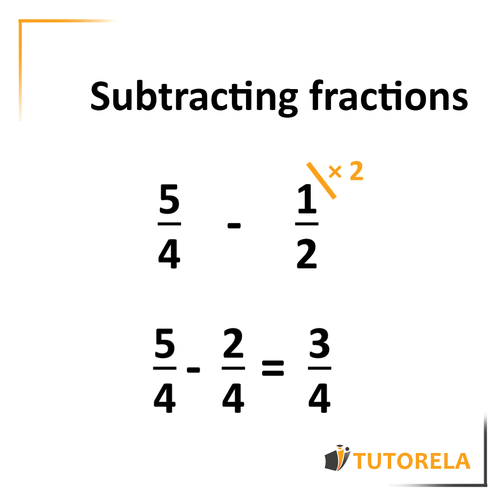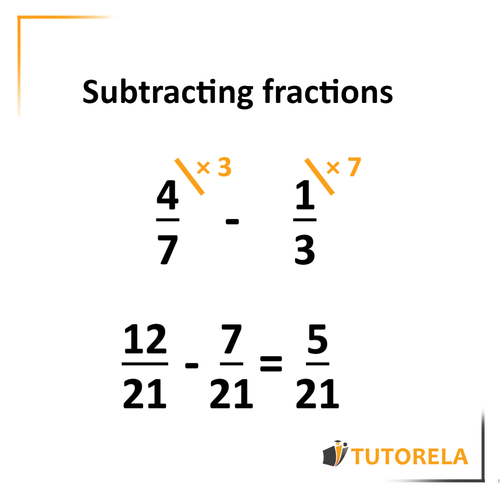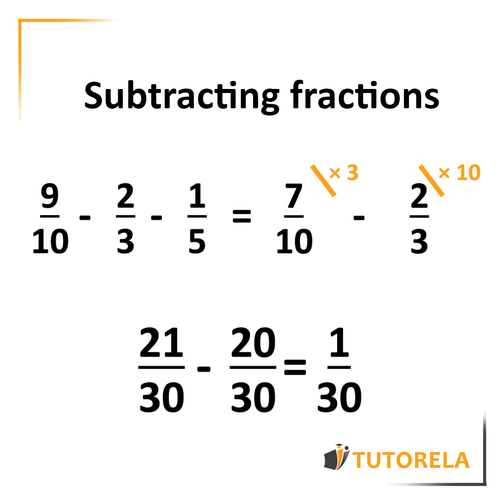To subtract fractions, we must find the common denominator by simplifying, expanding, or multiplying the denominators.
Then, we only need to subtract the numerators to get the result.
Subtraction of Fractions
Test yourself on subtraction of fractions!
Solve the following exercise:
\( \frac{8}{5}-\frac{4}{5}=\text{?} \)
Subtraction of Fractions
In this article, we will learn how to subtract fractions in a simple and quick way.
By the way, subtracting fractions is very similar to adding fractions, therefore, if you know how to add them, you will know how to subtract them without any problem.
Shall we start?
The first step to solving fraction subtractions is to find the common denominator.
This way, we will have two fractions with the same denominator.
We will do this by simplifying, expanding, or multiplying the denominators.
After finding the common denominator, ensuring that both fractions have the same denominator, we will move on to the second step of the resolution.
The second step to solve a subtraction of fractions is to subtract the numerators.
We will encounter different cases of subtractions that we will study below:
First case:
One of the denominators that appears in the initial exercise will be the common denominator.
Sometimes, we will have exercises in which it will be enough to carry out a single operation on a single fraction to achieve a common denominator.
Let's look at an example
Upon observing these denominators, we will immediately realize that, if we multiply the denominator by , we will reach the denominator .
This way, we will reach the common denominator and will be able to solve the exercise easily.
Observe - When multiplying the denominator to transform it into a common denominator, we must also multiply the numerator by the same number so that the value of the fraction does not change.
We will do this by multiplying by and we will obtain:
Now let's move to the second step and subtract the numerators.
Attention – We do not subtract the denominators.
When we obtain an identical common denominator only the numerators are subtracted and, from now on, the denominator is written only once.
Let's see it in an exercise
We subtract and leave the denominator only once.
If we wish, we can simplify the result and write it this way Another exercise:

Solution:
We will realize that, if we multiply by we will get this will be the common denominator.
We will obtain:
Let's subtract the numerators and we will get:
Solve the following exercise:
\( \frac{7}{5}-\frac{4}{5}=\text{?} \)
Solve the following exercise:
\( \frac{3}{3}-\frac{1}{3}=\text{?} \)
Solve the following exercise:
\( \frac{4}{6}-\frac{3}{6}=\text{?} \)
Second case
The common denominator will be the product of the given denominators.
Sometimes we will come across exercises in which it will not be enough to expand a single fraction to obtain the common denominator, but rather, we must intervene in both fractions.
In such a case, simply, we multiply the first fraction by the denominator of the second and the second fraction by the denominator of the first.
Let's look at an example

Let's multiply the denominators:
We will multiply by (the denominator of the second fraction) and by (the denominator of the first fraction).
We will obtain:
Let's subtract the numerators and we will arrive at the solution:
Tip - This method is technical and does not require us to think about how to find the common denominator.
Therefore, we recommend using it in all fraction subtraction exercises.
Third case
Subtraction of 3 Fractions
In case there were in the exercise fractions with different denominators, we will first find the common denominator for of them (the simplest ones), then we will find the common denominator between the obtained one and the third given fraction.
Let's see an example and you will understand how simple this is:
Let's look at the denominators and ask ourselves - Among the three denominators, which is it easier to find a common denominator for?
The answer is and , since is the common denominator for both.
Therefore, we will multiply by and obtain:
Now we can subtract the numerators that already have a common denominator to arrive at a clearer and more orderly exercise (this step is not mandatory, but it will help us later):

Now we just need to find the common denominator between , the new denominator we found, and the third denominator of the exercise.
We will do it with the method of multiplying denominators and obtain:
Let's subtract the numerators and we will obtain:
Examples and exercises with solutions for subtracting fractions
Exercise #1
Solve the following exercise:
Video Solution
Step-by-Step Solution
To solve the problem, we'll follow these steps:
- Step 1: Confirm the fractions have the same denominator. Here, both denominators are 5.
- Step 2: Subtract the numerators of the fractions: .
- Step 3: Write the result over the common denominator: .
Now, let's calculate:
Step 1: Both fractions and have a common denominator of 5.
Step 2: Subtract the numerators:
.
Step 3: Place the result over the common denominator:
.
Therefore, the solution to the problem is .
Answer
Exercise #2
Solve the following exercise:
Video Solution
Step-by-Step Solution
To solve this problem, we'll execute the following steps:
- Step 1: Identify like denominators.
- Step 2: Subtract numerators, keeping the common denominator.
- Step 3: Simplify if necessary.
Let's work through the solution:
Step 1: Both fractions, and , have the same denominator of 5.
Step 2: Subtract the numerators: .
Step 3: The result is , with no further simplification necessary.
The correct solution to the given subtraction problem is .
Answer
Exercise #3
Solve the following exercise:
Video Solution
Step-by-Step Solution
To solve this problem, let's follow these steps:
- Step 1: Identify and understand the problem
- Step 2: Analyze the structure of the fractions involved
- Step 3: Perform subtraction of like fractions
Now, let's work through each step:
Step 1: The problem asks us to subtract two fractions: and . These fractions have the same denominator, which means they are "like" fractions.
Step 2: In subtraction of fractions with like denominators, we only need to subtract the numerators while keeping the denominator the same. Let's set up the expression:
Step 3: Subtract the numerators:
So, the result of the subtraction is .
Therefore, the solution to the problem is .
Answer
Exercise #4
Solve the following exercise:
Video Solution
Step-by-Step Solution
The task is to perform a simple subtraction of fractions with like denominators. Here's how we solve it:
Initially, we have the fractions and . Both fractions have the same denominator, which is 6.
- Step 1: Since the denominators are the same, we subtract only the numerators. This means we subtract 3 from 4, as follows:
The fraction is already in its simplest form. Therefore, the result of subtracting from is .
The correct answer among the given choices is . This corresponds to choice number 2 in the list of options provided.
Therefore, the solution to the problem is .
Answer
Exercise #5
Solve the following exercise:
Video Solution
Step-by-Step Solution
To solve this problem, we'll subtract two fractions with a common denominator. Here is the step-by-step process:
- Step 1: Identify the numerators: The numbers on top of the fractions are 3 and 1.
- Step 2: Subtract the numerators: Calculate .
- Step 3: Retain the common denominator: Since the two fractions have the same denominator, 9, retain this in the result.
Thus, the result of subtracting from is .
Therefore, the solution to the problem is .
Answer
Solve the following exercise:
\( \frac{3}{9}-\frac{1}{9}=\text{?} \)
Solve the following exercise:
\( \frac{4}{5}-\frac{1}{5}=\text{?} \)
Solve the following exercise:
\( \frac{6}{6}-\frac{3}{6}=\text{?} \)
More Questions
Subtraction of Fractions
- Solve (1/4 + 7/4 - 5/4 - 1/4) × 10 ÷ 7 ÷ 5: Complete Solution
- Solve: -3/8 - (-5/8) - (-1/2) | Multiple Negative Fractions
- Solve -14/7 + (-3) - 1/2 - (-1/4): Combined Operations with Fractions
- Solve: -4/16 - (-3/8) + 2/8 + (-1/4) | Mixed Fraction Operations
- Solve: -3 + (-1/2) + (3/8) + 5/8 - Adding Mixed Fractions and Negative Numbers
- The Order of Basic Operations: Addition, Subtraction, and Multiplication
- Order of Operations: Exponents
- Order of Operations: Roots
- Division and Fraction Bars (Vinculum)
- The Numbers 0 and 1 in Operations
- Neutral Element (Identity Element)
- Order of Operations with Parentheses
- Order or Hierarchy of Operations with Fractions
- Opposite numbers
- Elimination of Parentheses in Real Numbers
- Addition and Subtraction of Real Numbers
- Multiplication and Division of Real Numbers
- Multiplicative Inverse
- Integer powering
- Positive and negative numbers and zero
- Real line or Numerical line
- Sum of Fractions
- Multiplication of Fractions
- Division of Fractions
- Comparing Fractions
- Mixed Numbers and Fractions Greater Than 1
- Addition and Subtraction of Mixed Numbers
- Multiplication of Integers by a Fraction and a Mixed Number
- Remainder of a fraction
- Remainder and Mixed Number
- Remainders
- Order of Operations - Exponents and Roots
- Special cases (0 and 1, reciprocals, fraction line)









